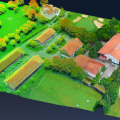
The possible effects of climate change on coastal areas of Australia have been outlined in a series of new maps launched by the Department of Climate Change and Energy Efficiency (DCCEE).
The maps, developed in partnership with the Co-operative Research Centre for Spatial Information (CRCSI), predict what would happen if sea levels rose by 0.5 metres, 0.8 metres and 1.1 metres in the next 90 years.
The maps use the highest resolution elevation data currently available to highlight low-lying areas in Melbourne, Sydney, Hunter and Central Coast NSW, Perth and South East Queensland.
Minister for climate change and energy efficiency Greg Combet said coastal areas were a priority for adaptation action.
“The maps provide useful initial information to decision-makers to prepare for potential risks from rising sea levels in coastal areas,” he said.
According to the DCCEE the maps are a communication tool and should not substitute detailed studies on sea-level rise. They do not take into account local factors, such as existing sea walls, changes in tidal flows and vulnerability to erosion.
A pilot sea-level rise virtualisation tool and an elevation data web portal have also been developed to allow government agencies to identify vulnerable areas.
CRCSI chief executive Peter Woodgate said the maps would be a useful tool to communicate risk.







